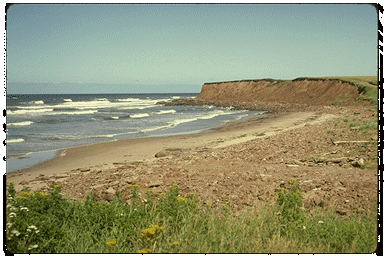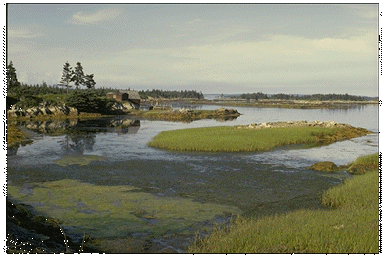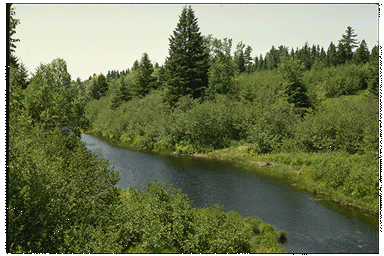
Salt marshes rimmed by placid lagoons and endless ribbons of sun-swept sand beaches blend into dark forests and tidy farmlands. Canada's warmest ocean waters and longest beaches make this region a magnet for vacationers. "The finest land one can see, and full of beautiful trees and meadows...", wrote Jacques Cartier in 1534 upon landing on Prince Edward Island.

THE LAND:
This is a gentle land. The surface slopes gently toward the sea, riding on horizontal strata of red sandstone, shale, conglomerates and mudstones. Where land meets sea are dune-edged beaches, salt marshes and warm lagoons. Offshore, a constantly shifting chain of barrier islands and reefs protects the shore from the fury of storms sweeping in from the Gulf of St. Lawrence.
VEGETATION
:...the trees are wonderfully beautiful and fragrant ... we discovered there were cedars, yew-trees, pines, white elms, ash trees, willows and others....
Jacques Cartier, 1534
Very little of this region's original forest remains. The huge white pines described by Cartier and other explorers were largely gone by the end of the eighteenth century, cut down for masts for sailing ships. The origio nal mixed wood forest of sugar maple, American beech, American elm, black ash, yellow birch, white pine and eastern hemlock has long been cleared for farms. Repeated logging, fires, insect epidemics and hurricanes have left only remnants of the original forest. Today, white spruce, black spruce, balsam fir and tamarack predominate. Large areas of muck and peat soils are present. Extensive salt marshes fringe the shore.The barrier islands and dunes are sparsely vegetated. Marram grass is the only plant that can initially colonize the dunes, stabilizing the shifting sands and enabling other species to become established.

WILDLIFE:
The extensive beaches and sand-dune systems provide critical nesting habitat for the piping plover, an endangered species. Common terns nest on the barrier islands. The lagoons, beaches and salt marshes are frequented by many species of ducks and shorebirds. Great blue herons stalk the salt marshes and shorelines.
Common mammals include white-tailed deer, snowshoe hare, black bear, porcupine and red fox. Moose are scarce. Grey seals and harbour seals frequent the lagoons and estuaries. As most of the region has been logged or farmed, species dependent on mature forests, such as wolf, caribou, martin and fisher, have disappeared. Coyotes have recently arrived, a new predator in the region.
Many of this region's rivers have runs of Atlantic salmon. The most famous is the Mirimichi, one of the richest Atlantic salmon rivers in eastern North America. But pollution from pulp and paper mills and mines threatens to reduce the run.

Two national parks represent this natural region. At Kouchibouguac National Park (239 km2), established by a federal-provincial agreement in 1979 with the Government of New Brunswick, salt marshes rimmed by placid lagoons and sand dunes of the offshore barrier islands gently blend into evergreen forests concealing bogs and cedar swamps. Piping plovers, an endangered species, and common terns nest on the beaches and barrier islands. Striped bass spawn in the estuaries. Much of the park has been logged and farmed in the past, and accordingly much of the forest is in an early successional stage. Several rivers gently flowing across the park inspired its Micmac name - "River of the long tides".
Sand dunes, red sandstone cliffs and endless sand beaches characterize Prince Edward Island National Park (22 km2). Established in 1937 by federal legislation, the park is a dynamic system of shifting sand carried by wind and waves. Ponds and marshes develop inland of sand spits and provide habitat for the many birds that nest here, including the endangered piping plover. Perhaps the best-known feature of the park is Green Gables House, made famous internationally through Lucy Maud Montgomery's classic novel Anne of Green Gables.